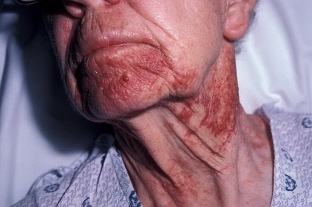Human skin is the main indicator of diseases of internal organs and structures, and it is very important to be able to recognize these signs. Metabolic disorders of various substances in the body are often accompanied by characteristic skin symptoms. For example, if darkish bumps appear on the surface of the skin, and it becomes rough – this may indicate a violation of metabolic processes, leading to the accumulation of pathological amyloid protein in the skin. In today's article on estet-portal.com, read about the characteristic symptoms and effective treatments for skin amyloidosis.
Clinical picture and methods of treatment of skin amyloidosis
Amyloidosis – it is a disease that develops as a result of disturbances in the metabolism of proteins, and is manifested by the deposition of amyloid in various tissues. When it comes to skin amyloidosis – this means that the symptoms of pathology appear on the skin.
If amyloidosis is systemic – this means that amyloid is deposited in the internal & nbsp; organs, and if only skin tissues are affected, lichenoid amyloidosis of the skin is diagnosed.
This form of pathology is treatable, but in some cases, the use of topical drugs is necessary all the time. For the effective treatment of a disease, it is very important to correctly establish its form and causes, and only then select a therapeutic regimen for the patient.
Skin amyloidosis:
- classification and main causes of skin amyloidosis;
- features of the clinical picture of skin amyloidosis;
- effective treatments for skin amyloidosis.
Classification and main causes of skin amyloidosis
There is an official classification of amyloidosis, according to which it is possible to distinguish various groups of causes that cause the disease:
- The primary systemic process is characterized by the deposition of amyloid in both the skin and internal organs of the patient. The reason for this is a genetic predisposition or the accidental appearance of a certain combination of genes that are responsible for the formation of altered cells in the skin and internal organs that synthesize the amyloid precursor;
- Secondary systemic amyloidosis is caused by diseases in which a toxin remains in the body for a long time. These include tuberculosis, syphilis, chronic bronchitis, nephritis, rheumatoid arthritis, tonsillitis, long-term caries and others;
- Lichenoid amyloidosis is characterized by the deposition of amyloid only in the skin. The secondary process can occur against the background of various dermatological diseases, such as neurodermatitis, eczema, various types of lichen, and so on. If we are talking about the primary process – its etiology is unknown.
Features of the clinical picture of skin amyloidosis
The clinical picture of skin amyloidosis depends on what form of the pathological process is observed in the patient:
- in the primary systemic process, the skin is not immediately affected, but the symptoms of damage to a certain internal organ come to the fore. Then skin symptoms join: the formation of dense nodules, plaques and small tumors, which are paler in color than the skin. The rash is localized in the natural folds of the skin, is not accompanied by itching or pain; The
- secondary systemic process is distinguished by the appearance of various elements of the rash: dense disk-shaped elements of a dark pink color, yellowish dense nodules, and plaques, as in psoriasis. At the same time, all rashes are accompanied by intense itching, and are localized on the chest, neck, face and even in the mouth;
- secondary cutaneous amyloidosis develops against the background of a long-term ongoing dermatological pathology, while the primary elements change, and a rough rash appears in them, resembling goosebumps;
- primary lichenoid amyloidosis occurs on clean skin in the form of nodules, spots or plaques of a conical or flat shape. Their characteristic features – dense texture, brown color, symmetrical arrangement, severe itching, multiple elements of the rash do not merge with each other, and areas of depigmented skin appear between them. Localization of lesions – on the shins, thighs, less often – on the face.

Effective treatments for skin amyloidosis
Treatment of skin amyloidosis involves prescribing the following drugs and procedures to the patient:
- glucocorticoid ointments;
- applications diluted with water 1:10 dimexide;
- laser therapy;
- drugs that reduce the intensity of pruritus;
- vitamin therapy;
- intradermal administration of glucocorticoids;
- intramuscular injections of 5% unithiol solution.
It is important to remember that for effective treatment of skin amyloidosis, first of all, it is necessary to correctly diagnose and establish the cause of the disease, and only in accordance with it select a therapeutic regimen.
Skin amyloidosis can be completely cured only with its local form, in other cases – treatment is aimed at improving the patient's quality of life.
In systemic forms of pathology, it is possible to stop the formation of amyloid protein, but it is impossible to completely remove it from the internal organs. estet-portal.com thanks you for your attention.
See also: «Skin amyloidosis: why protein metabolism disorders are dangerous».







Add a comment